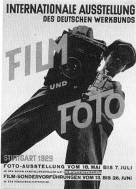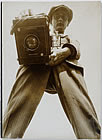FiFo - Film und Foto Internationale Ausstellung, Stuttgart 1929

Willi Ruge - Poster for FiFo - Film und Foto - Internationale Ausstellung des Deutschen Werkbunds, Stuttgart, 1929
(Modernism in Central Europe - Exhibition at the Washington National Gallery)
(Modernism, Designing a New World, 1914-1939 - Exhibition at the Corcoran Gallery of Art)
(Modernism in Central Europe - Exhibition at the Washington National Gallery)
(Modernism, Designing a New World, 1914-1939 - Exhibition at the Corcoran Gallery of Art)
Both exhibitions currently open in DC (at the National Gallery and at Corcoran) emphasize an important event in the history of the avant-garde of the 20s - 30s: FiFo (Film und Foto) - the Film and Photo International Exhibition that took place in Stuttgart in 1929.
FiFo made the point for the status of modern photography and cinema in Europe and America. It was the first big manifestation of its kind: it was the first time when representative works for America, Soviet Union and all Europe were gathered together.
The Fotoausstellung (Photo Exhibition) was open from May to July - the Filmsondervorfuehrungen (Film Special Demonstrations) took place two weeks in June.
The Photo Exhibition toured then in Zürich, Berlin, Danzig, Vienna, in the same year, 1929. In 1931 a selection of the exhibition was presented in Tokyo and Osaka. A follow-up exhibition, Das Lichtbild, toured Germany for 2 years, between 1930 - 1932.
FiFo was organized by the Deutscher Werkbund, the German Association of architects, designers and industrialists.
The Werkbund was less an artistic movement than a state-sponsored effort to integrate traditional crafts and industrial mass-production techniques, to put Germany on a competitive footing with England and the United States. Its motto Vom Sofakissen zum Städtebau (from sofa cushions to city-building) indicates its range of interest (Wikipedia).
One of the main promoters of the Film und Foto exhibition was Laszlo Moholy-Nagy. He designed the main room of the exhibition.
The artists from Bauhaus (with Moholy-Nagy as one of the leading figures there) were naturally very active presences in Fifo.
Willi Ruge created the poster for the exhibition. He used an older photo made by him, in 1927, showing his friend, photographer Arno Böttcher. Both of them were crazy about sports and aviation. I found on the web an old column from Time, from 1931 telling about them:
Three months ago two Germans, Willi Ruge and one Boettcher, made their first jumps from separate planes at Staaken Airdrome, Berlin, each armed with a small, specially designed automatic camera to photograph the other's descent and to take self-photographs during the jump. These pictures were printed six weeks ago in the Illustrated London News.

And here is Willi Ruge's 1931 shot: his own legs and feet dangling over an aerial view of Berlin during his seven-minute parachute jump (NY Times). The photo is called Der Fotograf and is a classic.

Willi Ruge typified the new breed of modern daredevil photojournalist, taking spectacularly composed pictures from parachutes, or from aircraft performing aerobatics or in combat. He was an official air force photographer in both world wars. His picture archive was destroyed in 1943 (Photography Encyclopedia).
(Filmele Avangardei)
(Modernism in Central Europe)

0 Comments:
Post a Comment
<< Home